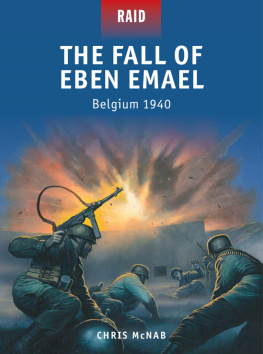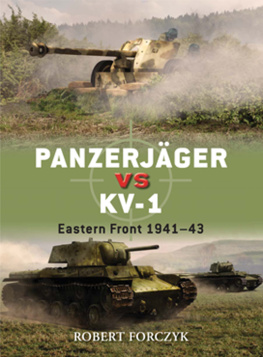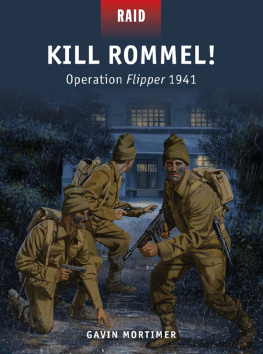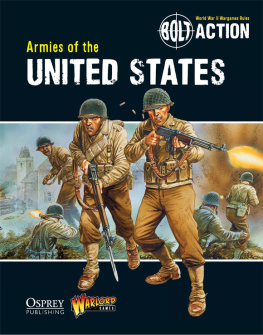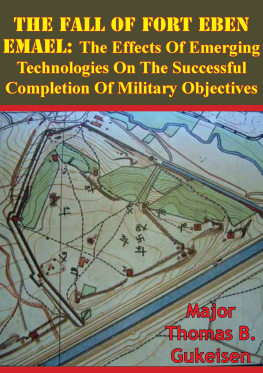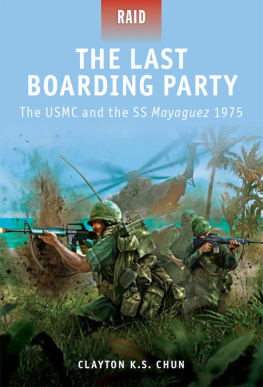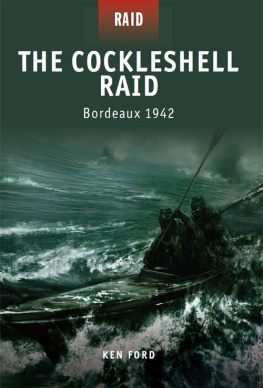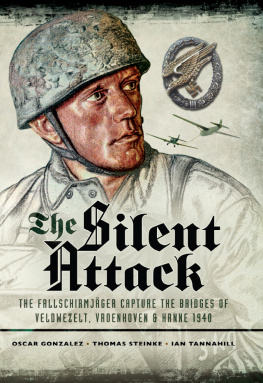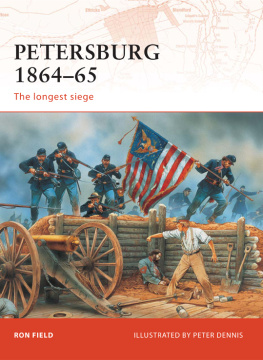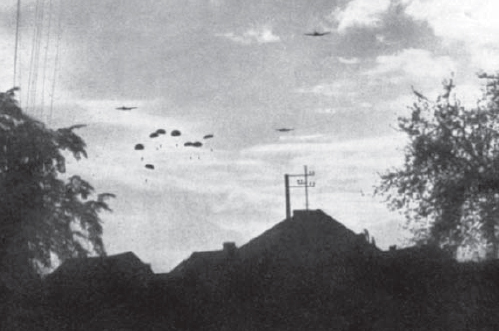THE FALL OF EBEN EMAEL
Belgium 1940
CHRIS McNAB
CONTENTS
INTRODUCTION
There are few better representations of elite soldiers or tactics in action than the raid on Eben Emael on 10 May 1940. Almost everything about the raid was cutting edge. The method of combat deployment an airborne assault by glider-landed troops was untested in action. The equipment carried by the Fallschirmjger (paratroopers) included devastating new shaped-charge explosive devices, designed specifically to destroy armour and reinforced ferro-concrete emplacements. The unit itself was ground-breaking, as airborne troops were only just beginning to add a third (vertical) dimension to the practice of warfare.
Added to the technological and tactical innovations at Eben Emael was the sheer audacity of what was being attempted. Just 85 men of Sturmgruppe Granit (Assault Group Granite) were assaulting one of the most powerful fortifications in the Western world, the objective covering 66 hectares (660,000m2), bristling with gun emplacements, and manned by a garrison of 1,200 Belgian troops. Despite the disparity in numbers and firepower, the small group of Germans were in control of the fort within a matter of hours. How they did so is one of the most compelling stories in military history.
Airborne warriors
The raid on Eben Emael was an early landmark in the development of an entirely new type of soldier the airborne soldier. By the time the first man jumped from a fixed-wing aircraft in 1911, parachutes and parachuting had been under sketchy, often lethal, development for nearly five centuries. Credit over who took that first 1911 jump is uncertain; it is variously attributed to Americans Grant Morton or Captain Albert Berry. Others soon followed, but the rather traditionalist military community were at first non-committal, or even derisive, over the tactical potential of the parachute as a method of combat deployment.
This position began to change during World War I and the immediate years after the Armistice in 1918. In 1914, US female aerial adventurer Georgia Tiny Broadwick made several demonstration jumps for American government and military officials. Not only did she perform four static-line deployments, but she also stunned observers by making a freefall drop and living to tell the tale. Now the US military community at least was sitting up and paying attention to parachutes, if only because of the potential for the parachute to improve the survivability of its airmen. Yet in October 1918, with the end of World War I just a month away, the innovative US Army commander, Brigadier General William Billy Mitchell (a passionate advocate of tactical airpower), proposed a radical way to conclude the fighting. The commander of the American Expeditionary Forces, General John Pershing, wanted to take the battle deep into the German heartland. The principal obstacle to this objective was Germanys superb defensive fortifications, particularly those integrated into the city of Metz. Mitchells proposed solution was to deploy the entire US 1st Division from bombers via parachute, dropping them well behind the Metz positions. There they would hold fast until ground forces could move up and close the gap. This concept of vertical deployment was not, for the time being, tested in practice, but the idea was revolutionary. By deploying troops from the air, using the distance-transcending qualities of aircraft, an army could place a force in the enemys rear without the necessity of crossing his defensive lines. Once there they could attack their opponents supply and communications infrastructure, force him to change his troop dispositions, and plunge him into tactical uncertainty. There was also the potential for enveloping and attacking fortifications from directly above, typically a blind spot in many major fort systems.
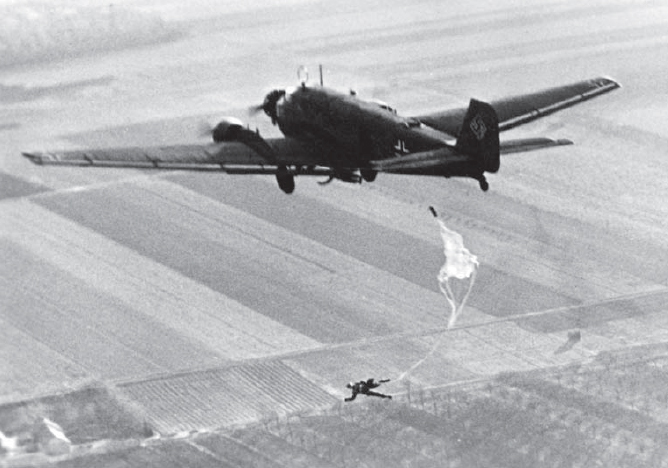
A Fallschirmjger makes a static-line parachute jump from a Ju 52 transport aircraft during a training exercise. This photo clearly illustrates the potential of vertical deployment offered by the development of airborne warfare during the 1930s, principally by Germany, Italy and the Soviet Union. (Cody Images)

Despite Mitchells bold speculations, it wasnt until the 1920s and 1930s that actual units of airborne troops began to develop in earnest, during which decades it was the Europeans who took the lead. Several signal events changed the game, albeit in haphazard fashion. The first was undoubtedly the emergence of more effective long-range transport/bomber aircraft, such as the Italian Caproni Ca.73 (the paratroop transport version was known as the Ca.80S), the Soviet Tupolev TB-3 and the German Junkers Ju 52. The parachute was also going through refinements. In 1927 the Italian static-line Salvatore parachute was introduced, offering paratroopers the ability to exit the aircraft quickly in tight sticks, concentrating them over the drop zone. Once allied to the British-developed quick-release harness, parachutes suddenly presented genuine tactical possibilities for the convenient deployment of airborne troops. At the same time, armies were also beginning to experiment with airlanding troops directly by aircraft, which offered the dimensional advantages of parachute deployment but without some of the physical risk and tactical dispersion.
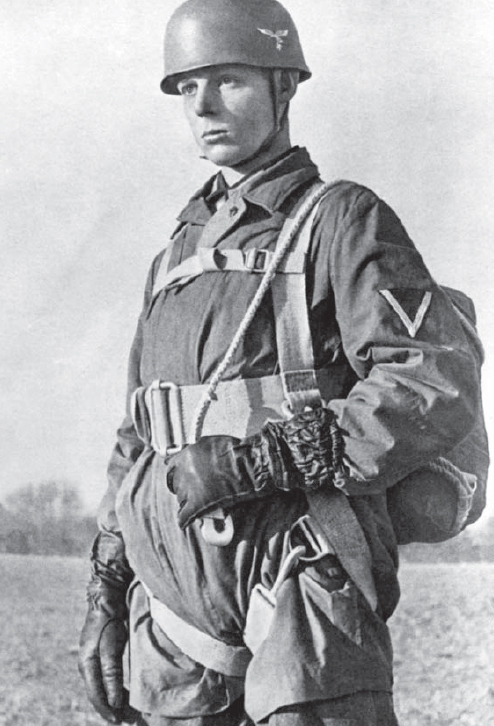
This close-up of a German paratrooper illustrates the typical jump kit of the 1930s and early war years. In his left hand he clutches the hook that would attach to the static line inside the deployment aircraft; the parachute pack can be seen on his back. (Cody Images)
While the Italians were arguably the first to form actual parachute units, doing so in the late 1920s, it was the Soviets of the 1930s who truly embraced the airborne principle. By 1931 the Red Army was performing small-unit parachute drops from converted bombers, but by 1933 airborne deployment was being conducted on regimental scale. Just two years later, the Soviets started to think big with manoeuvres in which 8,000 men were airlanded plus 3,000 paratroopers were dropped, along with associated light vehicles and equipments. Soviets were also working with glider-borne deployment methods as a more precise alternative to dropping men under wind-blown silk canopies.
By this time, Germany had also entered the airborne picture. Russia had become a convenient location for Germany to develop its military training and equipment away from the constraints imposed by the post-war Versailles Treaty. One man whose attention was immediately aroused by the sight of soldiers tumbling through the skies was the vainglorious commander-in-chief of the Luftwaffe, Hermann Gring, who had witnessed Soviet demonstrations in 1931 and 1935. With Heer (German Army) interest in parachute deployment distinctly lukewarm, Gring sensed an opportunity to steal a march. In 1933 Gring, in his other capacity as the chief of the Prussian police, had formed a small counter-terrorist unit known as Polizeiabteilung Wecke (Police Detachment Wecke), which also included a small parachute-deployable formation. The police detachment eventually swelled into the Regiment

